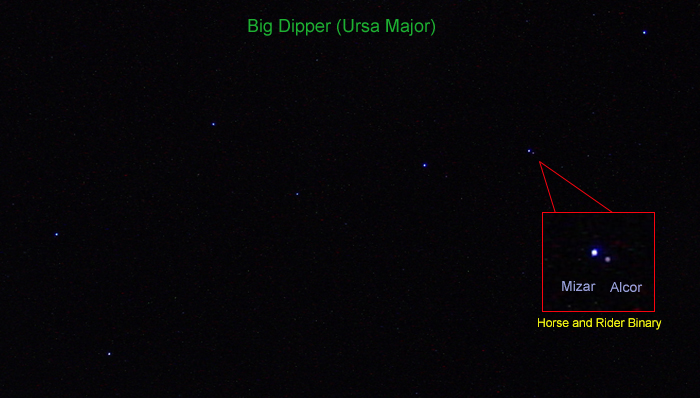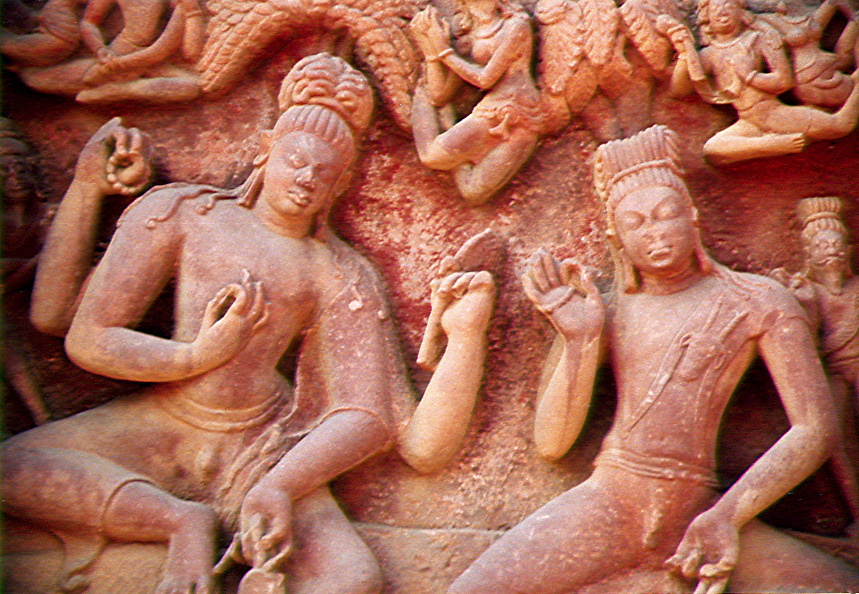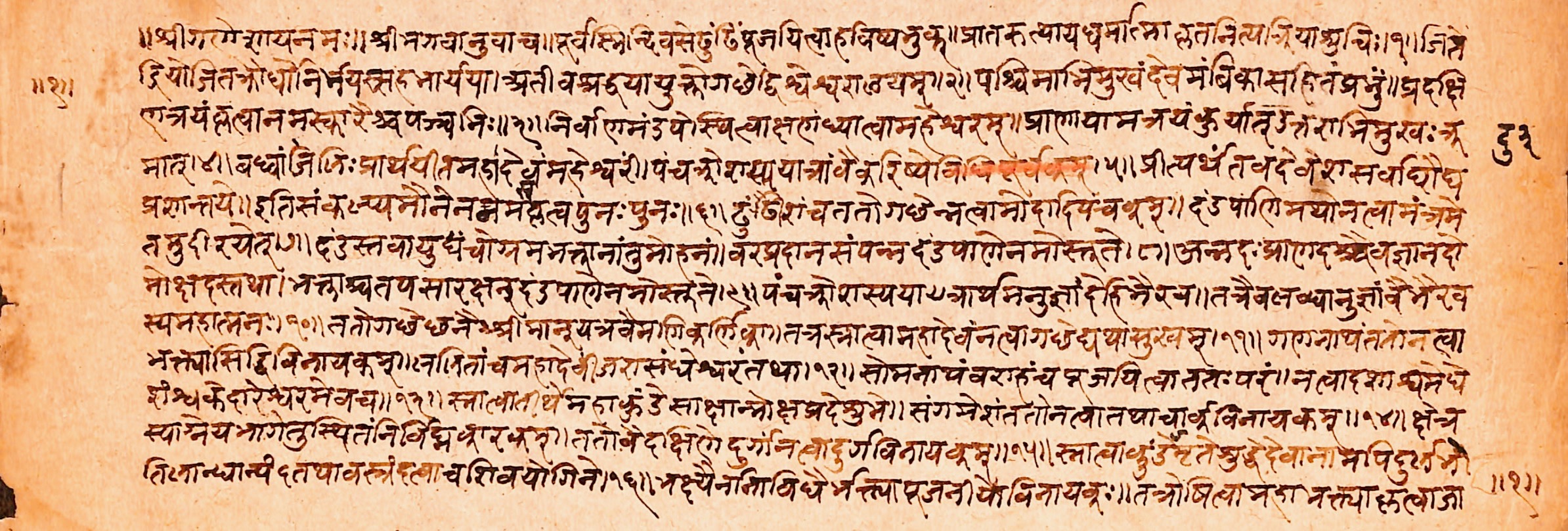|
Vasishtha
Vasishtha ( sa, वसिष्ठ, IAST: ') is one of the oldest and most revered Vedic rishis or sages, and one of the Saptarishis (seven great Rishis). Vashistha is credited as the chief author of Mandala 7 of the ''Rigveda''. Vashishtha and his family are mentioned in Rigvedic verse 10.167.4, other Rigvedic mandalas and in many Vedic texts. His ideas have been influential and he was called the first sage of the Vedanta school of Hindu philosophy by Adi Shankara. The '' Yoga Vasishtha'', ''Vasishtha Samhita'', as well as some versions of the ''Agni Purana'' and ''Vishnu Purana'' are attributed to him. He is the subject of many stories, such as him being in possession of the divine cow Kamadhenu and Nandini her child, who could grant anything to their owners. He is famous in Hindu stories for his legendary conflicts with sage Vishvamitra. In the Ramayana, he was the family priest of the Raghu dynasty and teacher of Rama and his brothers. Etymology Vasishtha is also spelled ... [...More Info...] [...Related Items...] OR: [Wikipedia] [Google] [Baidu] |
Arundhati (Hinduism)
Arundhati ( sa, अरुन्धती, translit=Arundhatī) is the wife of the sage Vasishtha, one of the seven sages ( Saptarshi) of Hinduism. Etymology The name in Sanskrit literally means 'washed from the rays of sun', from 'sun rays', and , 'washed'. Legend Arundhati's birth and life are mentioned in various Hindu scriptures. The birth of Arundhati is found in the Shiva Purana and Bhagavata Purana. The instruction by Brahma to Arundhati is described in the Uttara Kanda of the Ramcharitmanas. The rivalry between Vishvamitra and Vasishtha which leads to the death of her hundred sons is described in the Balakanda of Valmiki's Ramayana. The Mahabharata and several Brahmana works describe her sons, including Shakti, and grandson Parashara. Arundhati's meetings with Sita and Rama are mentioned in the Ramayana, Ramcharitmanas and Vinaya Patrika.Rambhadracharya 1994, pp. ''iii—vi''. Her role in pleading Shiva to marry Parvati is described in the sixth canto of Kuma ... [...More Info...] [...Related Items...] OR: [Wikipedia] [Google] [Baidu] |
Urvashi
Urvashi ( sa, उर्वशी, Urvaśī}) is the most prominent apsara (celestial nymph) in Hindu mythology, considered to be the most beautiful of all the apsaras, and an expert dancer. She is mentioned in both ''Vedic'' and ''Puranic'' scriptures and is often portrayed as a ' swan maiden'. Urvashi is described to be born out of the thigh of sage Narayana and occupies a special place in the court of Indra, the king of the gods and ruler of svarga (heaven). She is famous for her marriage to Pururavas, a mortal king, whom she later abandons. Urvashi is also regarded as the mother of Vedic sages Vashishtha and Agastya. Etymology The Sanskrit name ''"Urvaśī"'' can have multiple meanings. It is derived from roots''uru'' and ''aś''. Some believe that the name has a non- Aryan origin. According to the scripture ''Devi Bhagavata Purana'', the apsara is known as Urvashi because she is born from the ''uru''—'thigh'—of the divine-sage Narayana. Indologist Monier Monier-Wi ... [...More Info...] [...Related Items...] OR: [Wikipedia] [Google] [Baidu] |
Rigveda
The ''Rigveda'' or ''Rig Veda'' ( ', from ' "praise" and ' "knowledge") is an ancient Indian collection of Vedic Sanskrit hymns (''sūktas''). It is one of the four sacred canonical Hindu texts (''śruti'') known as the Vedas. Only one Shakha of the many survive today, namely the Śakalya Shakha. Much of the contents contained in the remaining Shakhas are now lost or are not available in the public forum. The ''Rigveda'' is the oldest known Vedic Sanskrit text. Its early layers are among the oldest extant texts in any Indo-European language. The sounds and texts of the ''Rigveda'' have been orally transmitted since the 2nd millennium BCE. Philological and linguistic evidence indicates that the bulk of the ''Rigveda'' Samhita was composed in the northwestern region of the Indian subcontinent (see) Rigvedic rivers), most likely between 1500 and 1000 BCE, although a wider approximation of 19001200 BCE has also been given. The text is layered, consisting of the ... [...More Info...] [...Related Items...] OR: [Wikipedia] [Google] [Baidu] |
Saptarishi
The Saptarishi () are the seven rishis of ancient India who are extolled in the Vedas, and other Hindu literature. The Vedic Samhitas never enumerate these rishis by name, although later Vedic texts such as the Brahmanas and Upanisads do so. Hinduism An early prototype of the "Saptarishi" concept may stem from the six families associated with the six "Family Books" in the Rigveda Samhita (Mandalas 2–7 in ascending order: Gṛtsamāda, Viśvāmitra, Vāmadeva, Atri, Bhardwaja, Vasiṣṭha). While not a "Family Book", Mandala 8 is mostly attributed to Kaṇva, who could be considered the 7th prototypical Saptarishi. The earliest formal list of the seven rishis is given by Jaiminiya Brahmana 2.218–221: Agastya, Atri, Bhardwaja, Gautama, Jamadagni, Vashistha, and Vishvamitra followed by Brihadaranyaka Upanisad 2.2.6 with a slightly different list: Atri, Bharadwaja, Gautama, Jamadagni, Kashyapa, Vashistha, and Vishvamitra. The late Gopatha Brahmana 1.2.8 has Vashisth ... [...More Info...] [...Related Items...] OR: [Wikipedia] [Google] [Baidu] |
Varuna
Varuna (; sa, वरुण, , Malay: ''Baruna'') is a Vedic deity associated initially with the sky, later also with the seas as well as Ṛta (justice) and Satya (truth). He is found in the oldest layer of Vedic literature of Hinduism, such as hymn 7.86 of the ''Rigveda''. He is also mentioned in the Tamil grammar work '' Tolkāppiyam'', as Kadalon the god of sea and rain. He is said to be the son of Kashyapa (one of the seven ancient sages). In the Hindu Puranas, Varuna is the god of oceans, his vehicle is a Makara (crocodile) and his weapon is a Pasha (noose, rope loop). He is the guardian deity of the western direction. In some texts, he is the father of the Vedic sage Vasishtha. Varuna is found in Japanese Buddhist mythology as Suiten. He is also found in Jainism. Etymology In Hindu tradition, the theonym ''Váruṇa'' (Devanagari: वरुण) is described as a derivation from the verbal root ''vṛ'' ("to surround, to cover" or "to restrain, bind") by means ... [...More Info...] [...Related Items...] OR: [Wikipedia] [Google] [Baidu] |
Saptarshi
The Saptarishi () are the seven rishis of ancient India who are extolled in the Vedas, and other Hindu literature. The Vedic Samhitas never enumerate these rishis by name, although later Vedic texts such as the Brahmanas and Upanisads do so. Hinduism An early prototype of the "Saptarishi" concept may stem from the six families associated with the six "Family Books" in the Rigveda Samhita (Mandalas 2–7 in ascending order: Gṛtsamāda, Viśvāmitra, Vāmadeva, Atri, Bhardwaja, Vasiṣṭha). While not a "Family Book", Mandala 8 is mostly attributed to Kaṇva, who could be considered the 7th prototypical Saptarishi. The earliest formal list of the seven rishis is given by Jaiminiya Brahmana 2.218–221: Agastya, Atri, Bhardwaja, Gautama, Jamadagni, Vashistha, and Vishvamitra followed by Brihadaranyaka Upanisad 2.2.6 with a slightly different list: Atri, Bharadwaja, Gautama, Jamadagni, Kashyapa, Vashistha, and Vishvamitra. The late Gopatha Brahmana 1.2.8 has Vashisth ... [...More Info...] [...Related Items...] OR: [Wikipedia] [Google] [Baidu] |
Purohita
Purohita ( sa, पुरोहित), in the Hindu context, means ''chaplain'' or ''family priest'' within the Vedic priesthood. In Thailand and Cambodia, it refers to the royal chaplains. Etymology The word ''purohita'' derives from the Sanskrit, ''puras'' meaning "front", and ''hita'', "placed". The word is also used synonymously with the word ''pandit'', which also means "priest". '' Tirtha purohita'' means the ''purohita'' who sit at the fords of the holy rivers or holy tanks and who have maintained the records of the forefathers of the Hindu family for thousands of years. ''Purohita'' can refer to a house priest. Education In India, literate men from the Brahmin varna who desire to become ''purohitas'' receive special training both in theory and practice in Vedic schools linked to agraharams, inherited from royal grants to train and sustain chaplains historically maintained by dynasties such as the Cholas and Pallavas. In fact, special training is required to perfor ... [...More Info...] [...Related Items...] OR: [Wikipedia] [Google] [Baidu] |
Rama
Rama (; ), Ram, Raman or Ramar, also known as Ramachandra (; , ), is a major deity in Hinduism. He is the seventh and one of the most popular '' avatars'' of Vishnu. In Rama-centric traditions of Hinduism, he is considered the Supreme Being. Rama is said to have been born to Kaushalya and Dasharatha in Ayodhya, the ruler of the Kingdom of Kosala. His siblings included Lakshmana, Bharata, and Shatrughna. He married Sita. Though born in a royal family, their life is described in the Hindu texts as one challenged by unexpected changes such as an exile into impoverished and difficult circumstances, ethical questions and moral dilemmas. Of all their travails, the most notable is the kidnapping of Sita by demon-king Ravana, followed by the determined and epic efforts of Rama and Lakshmana to gain her freedom and destroy the evil Ravana against great odds. The entire life story of Rama, Sita and their companions allegorically discusses duties, rights and social responsibil ... [...More Info...] [...Related Items...] OR: [Wikipedia] [Google] [Baidu] |
Śakti Maharṣi
Shakti Maharishi was son of Vaśiṣṭha and Arundhati. He was the father of Parāśara, mentioned in the ''Mahabharata''. There is a legend found in ''Mahabharata'' about Shakti Muni. Once King Kalmashapada, going hunting, killed many animals. Tired and being hungry and thirsty, he was proceeding through the woods. On the way, Rishi Shakti Maharishi came on the same path, from the opposite direction. The King ordered him to get out of his way. The Rishi addressed the King sweetly and said "O king, this is my way". In accordance with duty and tradition, a king should always make way for Brahmins. The king persisted in acting like a Rakshasa (demon). The Rishi cursed the king thus: "O worst of the worst kings, since thou persecutest an ascetic, like a Rakshasa, thou shalt from this day, became a Rakshasa subsisting on human flesh! Henceforth, O worst of kings! thou shalt wander over the earth, affecting human form!". He was the grandfather of Vyasa, author of the Indian epic ' ... [...More Info...] [...Related Items...] OR: [Wikipedia] [Google] [Baidu] |
Raghu Dynasty
The Solar dynasty (IAST: Suryavaṃśa or Ravivaṃśa in Sanskrit) or the Ikshvaku dynasty was founded by the legendary king Ikshvaku.Geography of Rigvedic India, M.L. Bhargava, Lucknow 1964, pp. 15-18, 46-49, 92-98, 100-/1, 136 The dynasty is also known as ("Solar dynasty" or "Descendants of the Sun") which means that this dynasty prays to the Sun as their God and their originator (the Gayatri Mantra is a prayer offered to the Sun God as the Sun is the main deity of the Solar Dynasty), and along with Lunar dynasty comprises one of the main lineages of the Kshatriya Varna. The first ''Tirthankara'' of Jainism, Rishabhdeva himself was King Ikshvaku. Further, 21 Tirthankaras of Jainism were born in this dynasty. According to Buddhist texts and tradition, Gautama Buddha descended from this dynasty. Many later kings of the Indian subcontinent claimed to be of Suryavamsha descent. The important personalities belonging to this royal house are Mandhatri, Muchukunda, Ambarisha, B ... [...More Info...] [...Related Items...] OR: [Wikipedia] [Google] [Baidu] |
Agni Purana
The ''Agni Purana'', ( sa, अग्नि पुराण, ) is a Sanskrit text and one of the eighteen major Puranas of Hinduism. The text is variously classified as a Purana related to Shaivism, Vaishnavism, Shaktism and Smartism, but also considered as a text that covers them all impartially without leaning towards a particular theology. The text exists in numerous versions, some very different from others. The published manuscripts are divided into 382 or 383 chapters, containing between 12,000 and 15,000 verses. The chapters of the text were likely composed in different centuries, with earliest version probably after the 7th-century,Thomas Green (2001). ''Martial Arts of the World: An Encyclopedia'', ABC-CLIO, , page 282 but before the 11th century because the early 11th-century Persian scholar Al-Biruni acknowledged its existence in his memoir on India. The youngest layer of the text in the ''Agni Purana'' may be from the 17th century. The ''Agni Purana'' is a medieval er ... [...More Info...] [...Related Items...] OR: [Wikipedia] [Google] [Baidu] |
Sudas
Sudās Paijavana ( sa, सुदास्) was an Indo-Aryan tribal king of the Bharatas, during the main or middle Rigvedic period (c. 14th century BCE). He led his tribe to victory in the Battle of the Ten Kings near the Paruṣṇī (modern Ravi River) in Punjab, defeating an alliance of the powerful Puru tribe with other tribes, for which he was eulogised by his purohita Vashistha in a hymn of the Rigveda. His victory established the ascendency of the Bhārata clan, allowing them to move eastwards and settle in Kurukshetra, paving the way for the emergence of the Kuru "super-tribe" or tribal union, which dominated northern India in the subsequent period. Family Sudās' ancestors include Pijavana, Divodāsa Atithigva, and Devavant, although scholars disagree regarding the order of these ancestors chronologically. According to Witzel, Divodāsa was the father of Sudās, but he includes Pijavana on the grid of Bharata descent as a possible ancestor between Divodāsa an ... [...More Info...] [...Related Items...] OR: [Wikipedia] [Google] [Baidu] |



.png)


_Bhumi_Puja%2C_yajna.jpg)


